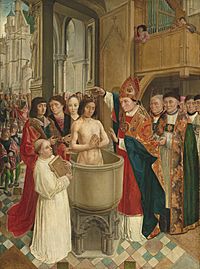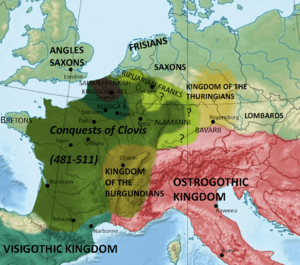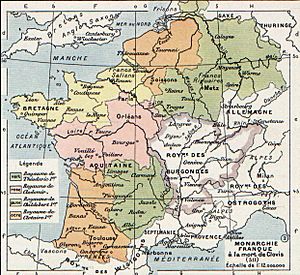Clovis I facts for kids
Quick facts for kids Clovis I |
|
|---|---|
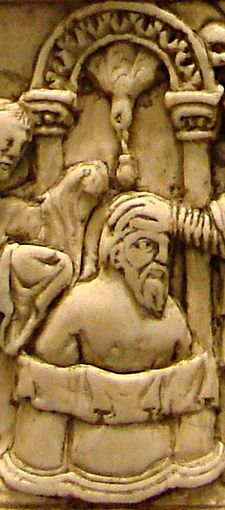
Baptism of Clovis, ivory book cover, 9th century
|
|
| King of the Franks | |
| Reign | 509–511 |
| Successor | Clotaire I (Soissons) Childebert I (Paris) Chlodomer (Orléans) Theuderic I (Rheims) |
| King of the Salian Franks | |
| Reign | 481–509 |
| Predecessor | Childeric I |
| Born | 466 Tournai (Belgium) |
| Died | November 27, 511 (aged 44 or 45) Paris (France) |
| Burial | Originally St. Genevieve Church Now Saint-Denis Basilica |
| Spouse | Clotilde |
| Issue | Ingomer Chlodomer Childebert I Chlothar I Clotilde Theuderic I |
| Dynasty | Merovingian |
| Father | Childeric I |
| Mother | Basina of Thuringia |
| Religion | pre-Schism Catholicism |
Clovis (Latin: Chlodovechus; reconstructed Frankish: *Hlōdowig; c. 466 – November 27, 511) was the first king of the Franks to unite all of the Frankish tribes under one ruler, changing the form of leadership from a group of royal chieftains to rule by a single king and ensuring that the kingship was passed down to his heirs. He is considered to have been the founder of the Merovingian dynasty, which ruled the Frankish kingdom for the next two centuries. Clovis is important in the historiography of France as "the first king of what would become France".
Clovis succeeded his father, Childeric I, as a king of Salian Franks in 481, and eventually came to rule an area extending from what is now the southern Netherlands to northern France, corresponding in Roman terms to Gallia Belgica (northern Gaul). At the Battle of Soissons (486) he established his military dominance of the rump state of the fragmenting Western Roman Empire which was then under the command of Syagrius. By the time of his death in either 511 or 513, Clovis had conquered several smaller Frankish kingdoms in the northeast of Gaul including some northern parts of what is now France. Clovis also conquered the Alemanni tribes in eastern Gaul, and the Visigothic kingdom of Aquitania in the southwest. These campaigns added significantly to Clovis's domains, and established his dynasty as a major political and military presence in western Europe.
Clovis was born a pagan but later became interested in converting to Arian Christianity. Clovis is significant due to his conversion to Christianity in 496, largely at the behest of his wife, Clovis' wife Clotilde, a Burgundian princess, was a Catholic despite the Arianism that surrounded her at court who would later be venerated as a saint for this act, she is still celebrated today in both the Roman Catholic Church and Eastern Orthodox Church.
Clovis was baptized on Christmas Day in 508. The adoption by Clovis of Catholicism (as opposed to the Arianism of most other Germanic tribes) led to widespread conversion among the Frankish peoples.
Clovis and his wife were buried in the Abbey of St Genevieve (St. Pierre) in Paris; the original name of the church was the Church of the Holy Apostles.
Contents
Background
Clovis was the son of Childeric I, a Merovingian king of the Salian Franks, and Basina, a Thuringian princess. The dynasty he founded is, however, named after his supposed ancestor, Merovich. Clovis succeeded his father to become king at the age of 15 in 481, as deduced from Gregory of Tours placing the Battle of Tolbiac (Zülpich) in the fifteenth year of Clovis's reign.
Numerous small Frankish petty kingdoms existed during the 5th century. The Salian Franks were the first-known Frankish tribe that settled with official Roman permission within the empire, first in Batavia in the Rhine-Maas delta, and then in 375 in Toxandria, which in the present day consists of the province of North Brabant in the Netherlands and parts of neighbouring provinces of Antwerp and Limburg in Belgium. This put them in the north part of the Roman civitas Tungrorum, with Romanized population still dominant south of the military highway Boulogne-Cologne. Later, Chlodio seems to have attacked westwards from this area to take control of the Roman populations in Tournai, then southwards to Artois, and Cambrai, eventually controlling an area stretching to the Somme river.
Childeric I, Clovis's father, was reputed to be a relative of Chlodio, and was known as the king of the Franks that fought as an army within northern Gaul. In 463 he fought in conjunction with Aegidius, the magister militum of northern Gaul, to defeat the Visigoths in Orléans. Childeric died in 481 and was buried in Tournai; Clovis succeeded him as king, aged just 15. Historians believe that Childeric and Clovis were both commanders of the Roman military in the Province of Belgica Secunda and were subordinate to the magister militum. The Franks of Tournai came to dominate their neighbours, initially aided by the association with Aegidius.
The death of Flavius Aetius in 454 led to the decline of imperial power in Gaul; leaving the Visigoths and the Burgundians competing for predominance in the area. The part of Gaul still under Roman control emerged as a kingdom under Syagrius, Aegidius's son.
Though no primary sources expounding on the language spoken by Clovis exist, historical linguist consider it likely that, based on his family history and core territories, he spoke a form of Old Dutch. In this, the early Merovingians can be contrasted with the later Carolingians, such as Charlemagne, of the late 8th century and onward, who probably spoke various forms of Old High German.
Early reign (481–491)
Road to Soissons
The ruler of Tournai died in 481 and was succeeded by his sixteen-year-old son, Clovis. His band of warriors probably numbered no more than half a thousand. In 486 he began his efforts to expand the realm by allying himself with his relative, Ragnachar, regulus of Cambrai and another Frankish regulus, Chalaric. Together the triumvirate marched against Syagrius and met the Gallo-Roman commander at Soissons. During the battle Chalaric betrayed his comrades by refusing to take part in the fighting. Despite the betrayal, the Franks landed a decisive victory, forcing Syagrius to flee to the court of Alaric II. This battle is viewed as bringing about the end of the rump state of the Western Roman Empire outside of Italy. Following the battle, Clovis invaded the traitor Chalaric's territory and was able to imprison him and his son.
Taming Gaul
Prior to the battle, Clovis did not enjoy the support of the Gallo-Roman clergy, so he proceeded to pillage the Roman territory, including the churches. The Bishop of Reims requested Clovis return everything taken from the Church of Reims; the young king aspired to establish cordial relationships with the clergy, so he returned a valuable ewer taken from the church. Despite his position, some Roman cities refused to yield to the Franks, namely Verdun ‒ which surrendered after a brief siege ‒ and Paris, which stubbornly resisted a few years, perhaps as many as five. He made Paris his capital and established an abbey dedicated to Saints Peter and Paul on the south bank of the Seine.
Realizing that he would not be able to rule Gaul without the help of the clergy, Clovis took a Nicene Christian wife to please them. He also integrated many of Syagrius's units into his own army. The Roman kingdom was probably under Clovis's control by 491, because in the same year Clovis successfully moved against a small number of Thuringians in the eastern Gaul, near the Burgundian border.
Middle reign (492–506)
Barbarian bonding
Around 493 AD, he secured an alliance with the Ostrogoths through the marriage of his sister Audofleda to their king, Theodoric the Great. In the same year, the neighboring King of the Burgundians was slain by his brother, Gundobad; bringing civil strife to that kingdom. Allegedly, Gundobad proceeded to kill his sister-in-law and force his niece, Chrona, into a convent. Another niece, Clotilde, fled to the court of the third brother, Godegisel. Finding himself in a precarious position, Godegisel decided to ally himself to Clovis by marrying his exiled niece to the Frankish king.
Assault of the Alamanni
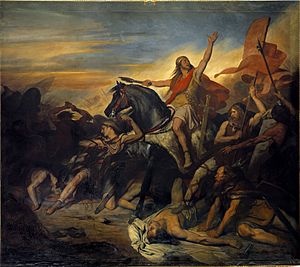
In 496, the Alamanni invaded and some Salians and Ripuarians reguli defected to their side. Clovis met his enemies near the strong fort of Tolbiac. During the fighting, the Franks suffered heavy losses. Clovis, together with over three thousand Frankish companions, may have converted to Christianity around this time. With the help of the Ripuarian Franks he narrowly defeated the Alamanni in the Battle of Tolbiac in 496. Now Christian, Clovis confined his prisoners, Chararic and his son, to a monastery.
Business in Burgundy
In 500 or 501, Godegisel began scheming against his brother Gundobad. He promised his brother-in-law territory and annual tribute for defeating his brother. Clovis was eager to subdue the political threat to his realm and crossed into the Burgundian territory. Gundobad then moved against Clovis and called his brother for reinforcements. The three armies met near Dijon, where both the Franks and Godegisel's forces defeated the dumbfounded Gundobad, who escaped to Avignon. Clovis pursued him and laid siege to the city. After some months, Clovis was convinced to abandon the siege and settled for an annual tribute from Gundobad.
Armorici allies
In 501, 502 or 503, Clovis led his troops to Armorica. He had previously restricted his operations to minor raids, but now the goal was subjugation. Clovis failed to complete this objective via military means; therefore, he was constrained to statecraft. This proved fruitful, for the Armonici shared Clovis's disdain for the Arian Visigoths. Armorica and its fighters were thus integrated into the Frankish realm.
Late reign (507–511)
Visiting the Visigoths
In 507 Clovis was allowed by the magnates of his realm to invade the remaining threat of the Kingdom of the Visigoths. King Alaric had previously tried to establish a cordial relationship with Clovis by serving him the head of exiled Syagrius on a silver plate in 486 or 487. However, Clovis was no longer able to resist the temptation to move against the Visigoths, for many Nicene Christians under Visigoth yoke were unhappy and implored Clovis to make a move. But just to be absolutely certain about retaining the loyalties of the Nicene Christians under Visigoths, Clovis ordered his troops to omit raiding and plunder, for this was not a foreign invasion, but a liberation.
Armonici assisted him in defeating the Visigothic kingdom of Toulouse in the Battle of Vouillé in 507, eliminating Visigothic power in Gaul. The battle added most of Aquitaine to Clovis's kingdom and resulted in the death of the Visigothic king Alaric II.
According to Gregory of Tours, following the battle the Byzantine Emperor Anastasius I made Clovis a patrician and honorary consul.
Ravishing the Reguli
In 507, following Vouillé, Clovis heard about Chararic's plan to escape from his monastic prison and had him murdered.
In the same year, Clovis convinced Prince Chlodoric to murder his father. Following the murder, Clovis betrayed Chlodoric and had his envoys strike him down.
In 509, Clovis visited his old ally, Ragnachar in Cambrai. Following his conversion, many of his pagan retainers had defected to Ragnachar's side, making him a political threat. Ragnachar denied Clovis's entry, prompting Clovis to make a move against him. He bribed Ragnachar's retainers and soon, Ragnachar and his brother, Ricchar were captured and executed.
Death
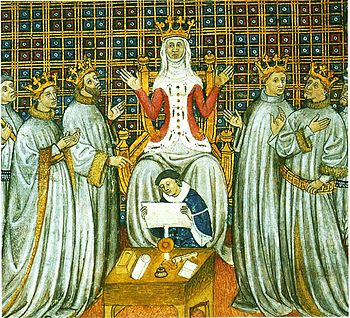
Shortly before his death, Clovis called a synod of Gallic bishops to meet in Orléans to reform the Church and create a strong link between the Crown and the Nicene Christian episcopate. This was the First Council of Orléans. Thirty-three bishops assisted and passed 31 decrees on the duties and obligations of individuals, the right of sanctuary, and ecclesiastical discipline. These decrees, equally applicable to Franks and Romans, first established equality between conquerors and conquered.
Clovis I is traditionally said to have died on 27 November 511; however, the Liber Pontificalis suggests that he was still alive in 513, so the exact date of his death is not known. After his death, Clovis was laid to rest in the Abbey of St Genevieve in Paris. His remains were relocated to Saint Denis Basilica in the mid- to late 18th century.
When Clovis died, his kingdom was partitioned among his four sons, Theuderic, Chlodomer, Childebert and Clotaire. This partition created the new political units of the Kingdoms of Rheims, Orléans, Paris and Soissons, and inaugurated a tradition that would lead to disunity lasting until the end of the Merovingian dynasty in 751. Clovis had been a king with no fixed capital and no central administration beyond his entourage. By deciding to be interred at Paris, Clovis gave the city symbolic weight. When his grandchildren divided royal power 50 years after his death in 511, Paris was kept as a joint property and a fixed symbol of the dynasty.
The disunity continued under the Carolingians until, after a brief unity under Charlemagne, the Franks splintered into distinct spheres of cultural influence that coalesced around Eastern and Western centers of royal power. These later political, linguistic, and cultural entities became the Kingdom of France, the myriad German States, and the semi-autonomous kingdoms of Burgundy and Lotharingia.
Legacy
The legacy of Clovis's conquests, a Frankish kingdom that included most of Roman Gaul and parts of western Germany, survived long after his death. To the French people, he is the founder of France.
By his conversion to Christianity he made himself the ally of the papacy and its protector as well as that of the people, who were mostly Catholics.
Images for kids
-
Tomb of Clovis I at the Basilica of St Denis in Saint Denis
-
Battle of Tolbiac. Fresco at the Panthéon (Paris) by Joseph Blanc, circa 1881
-
Statue depicting the baptism of Clovis by Saint Remigius
-
Clovis statue at the Abbey Church of Saint-Denis
See also
 In Spanish: Clodoveo I para niños
In Spanish: Clodoveo I para niños


